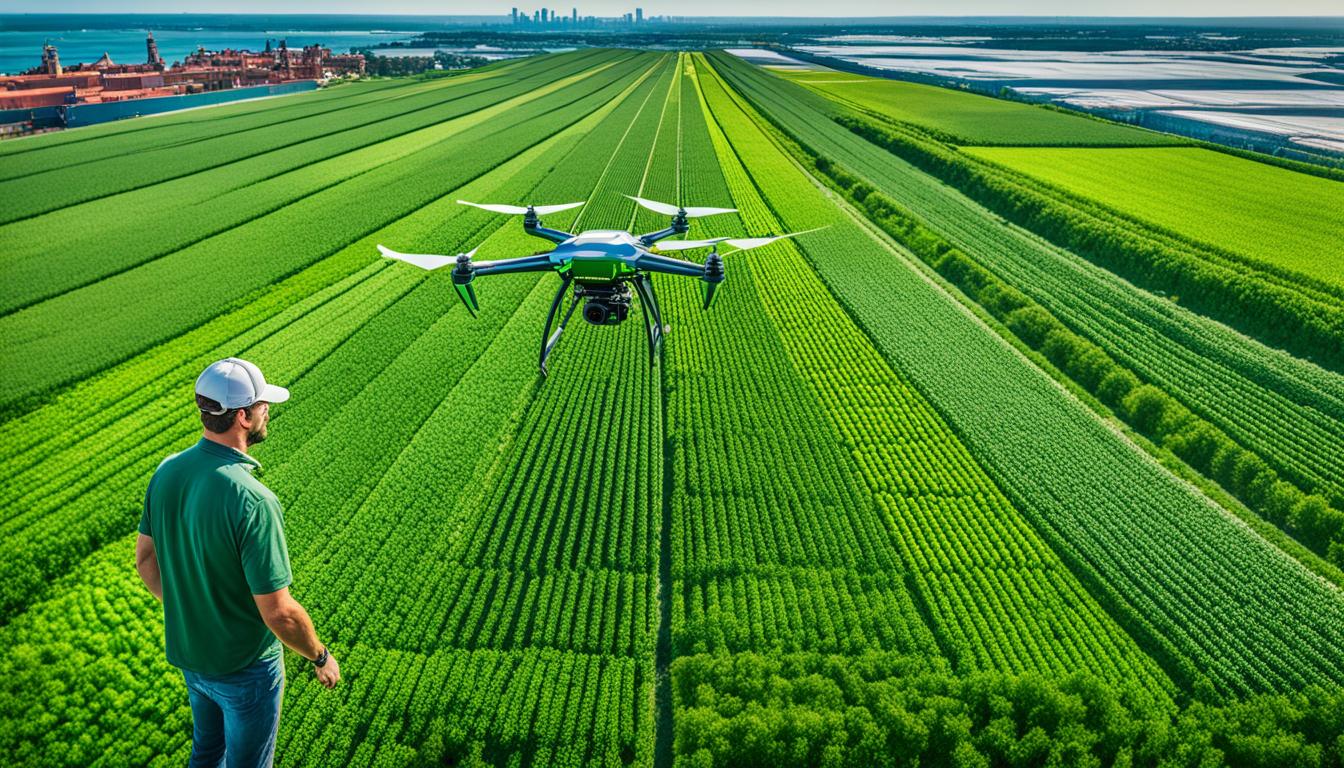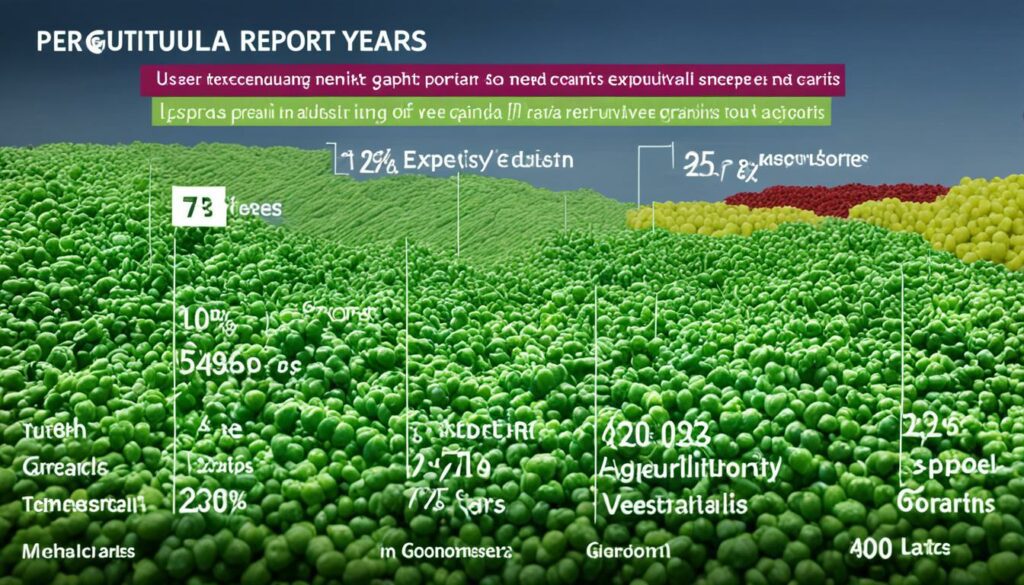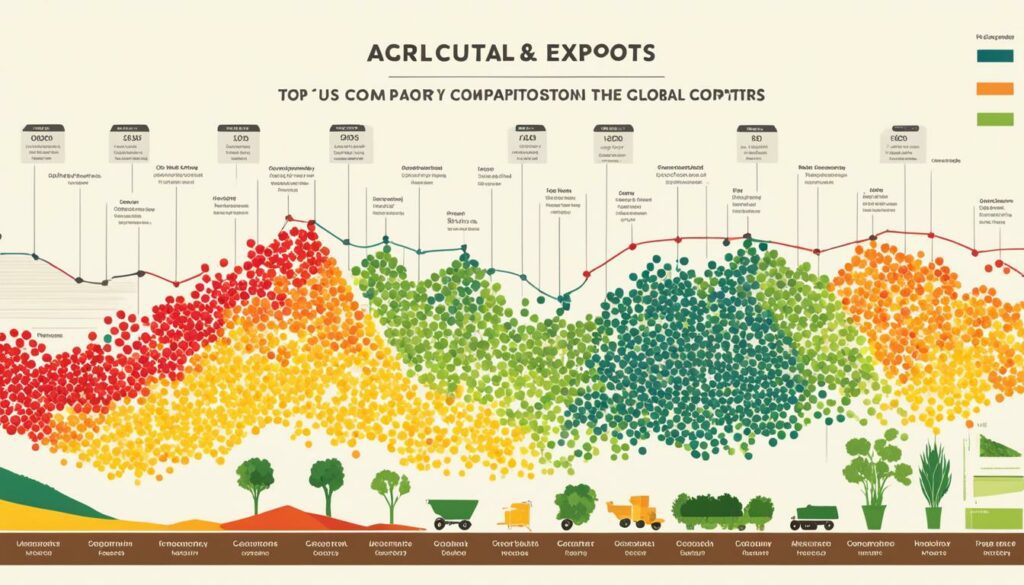Menu

In a twist, U.S. agricultural exports may rise to $170.5 billion in 2024, a $1.0 billion increase. But, beef production might fall by 1.70 billion pounds. This oddity shows how complex and surprising the export trends can be.
A report titled “Outlook for U.S. Agricultural Trade: February 2024” states that livestock, dairy, grains, and feeds will boost this growth. Even with less beef available, beef exports could go up by $700 million. This is because prices are higher and there’s less beef at home. Pork sales could increase by $600 million. This is helped by high prices and lots of exports to North America. Dairy exports are also set to boost by $500 million. This is because prices have risen for major dairy products.
Yet, not everything looks bright. The report sees a drop in soybean exports’ volume and value. This is mostly because South American producers are putting up tough competition. The forecast uses the February 8, 2024 WASDE release. This shows how much government policies affect export trends.
In 2024, the world of agricultural exports is both lively and full of challenges. It’s heavily influenced by global competition and changing demand. The latest policies, seen in the 2024 WASDE report, show these trends clearly. China is still a top market, facing new rivals from South America. Yet, exports to Mexico and Canada are on the rise. This shows how dynamic the global agricultural trade is this year.
There is a growing desire for food items like dairy, meat, and fresh produce worldwide. Export values have jumped from $62.8 billion in 1997 to $196 billion in 2022. This shows how farms in the U.S. are meeting global needs. Since 2013, the U.S. has kept about 20% of this global market share steady.
Looking back, the agricultural export scene has changed a lot. Just in 2021, the U.S. exported $177.3 billion more, boosting the economy by $190.5 billion. This helped create over 1 million jobs. For each dollar from an agricultural export, there was a $1.07 business boost. In 2022, horticultural products made up more than half of U.S. exports. The share of imports in the U.S. food and beverage market also grew, showing increased global connections.
These figures clearly show how the industry reacts to world changes. They show the key role of analyzing global agricultural trade. This analysis shapes how exports work in 2024.
The link between global economics and agricultural exports is deep and complex. Things like geopolitical tension, inflation, and the chance of a recession all affect U.S. agriculture exports in 2024. Knowing these factors helps see how the market might change and how it will affect trade.

Geopolitical tensions, like those from the Ukraine conflict, really matter for agriculture exports. This fight changes oil prices and the value of the U.S. dollar, affecting U.S. agricultural exports’ costs and competitiveness. Also, trade policies change, affecting market access and how much is exported. Data from the USDA and ERS show how such events impacted trade in the past.
In U.S. agriculture exports, inflation and a possible recession are key issues. Recent reports show that U.S. economic health directly links to its ability to export. High inflation can raise production costs, making U.S. goods less competitive.
A potential recession can lower purchasing power globally, affecting U.S. export demand. A USDA Outlook for U.S. Agricultural Trade talks about the possible economic impacts on exports for the year. It helps spot economic risks and make plans to reduce their effects on exports.
The combination of geopolitical issues and economic parameters shows a complex future for U.S. agriculture exports. This thinking aligns with USDA’s yearly predictions and ERS’s analysis, showing how trade volume and market position are linked to these factors.
Knowing how these issues work together is vital for all involved, from policymakers to farmers. The complex mix of global tension and economic state shapes U.S. agriculture export trends for 2024 and the future.
In 2024, U.S. agricultural exports may face both uphill tasks and golden chances. Examining the export market predictions unveils a mix. Some well-known markets might see some struggle, but new markets shimmer with growth hopes.
Mexico seems ready to shine in 2024. It might achieve $28.4 billion in farm produce exports, indicating its growing role in trading. This underlines trade as pivotal in Mexico’s and the region’s economic picture.
Places like Southeast Asia are also making their mark. Thanks to varied demand, products like soyoil are in high demand. Soyoil’s need is set to jump by $200 million, mainly because of the boom in renewable diesel.
Canada and China, despite their economic woes, offer stability for U.S. exports. Canada will buy a lot, especially in grains and feed, although forecasted a bit lower than before. It’s still a strong market at an estimated $37.5 billion.
U.S.-China trade, on the other hand, might slow to $29.5 billion. This is influenced by a stronger Dollar and China’s cooling economy. But still, this trading link remains key for U.S. trade in face of global ups and downs.
The export market predictions show a mixed bag. There will be some dips, but with emerging markets growing and the reliability of traditional partners, the outlook remains solid for U.S. agricultural exports in 2024.
Livestock and dairy exports will be key in 2024. Trends suggest big changes in beef, pork, and dairy. Let’s look at the standout points for this year.
Beef exports are set to drop by $300 million to $8.2 billion. This is because of low U.S. supplies affecting the market. Pork exports are also expected to fall, down by $300 million to $6.6 billion, mainly from less demand in Asia. Despite these challenges, these trades are vital for the industry facing changing global conditions.

Export trends for dairy products are heading south, with a $200 million drop to $7.2 billion. The main reason is less competitive prices in the global market. But, the dairy sector shows resilience. It aims to boost its export numbers through innovation and new market strategies.
Here’s a summary of the 2024’s key stats in livestock and dairy exports:
| Commodity | 2024 Forecast | Change from August |
|---|---|---|
| Beef Exports | $8.2 billion | – $300 million |
| Pork Exports | $6.6 billion | – $300 million |
| Dairy Products | $7.2 billion | – $200 million |
In 2024, the grains and feeds analysis shows a mixed picture. Corn and sorghum exports are expected to go up. But there might be less soybean exports ahead.
The new year is looking good for corn and sorghum exports, possibly gaining $700 million. This bright outlook follows the grain and feed exports’ pattern, which could reach $38.2 billion. Improved prices and strong demand worldwide lead this growth.
On the other hand, soybean exports might not do so well due to fierce competition from South American producers. This fight for market share affects both the amount and value of U.S. soybeans sold. It’s a tough situation that demands a careful strategy.
The grains and feeds report highlights changes in the market. Knowing these trends well helps everyone involved make smart decisions in the global market for growth.
For more details, check out the USDA ERS report on the “Outlook for U.S. Agricultural Trade: February 2024”: Outlook for U.S. Agricultural Trade.
| Commodity | Export Increase (in $ million) |
|---|---|
| Corn | 700 |
| Sorghum | 700 |
| Soybeans | -1,000 |
In the U.S., horticultural exports have stayed strong even when markets shift. The value expected for 2024 is $39.5 billion. This shows a big worldwide need for horticultural goods. It also proves that many people want high-quality produce.
“In fiscal year 2023, horticultural products constituted at least half the value of U.S. agricultural imports, driven by consumers’ year-round demand and evolving tastes.”
The need for global horticultural products shapes how much is exported. Over the last ten years, U.S. exports grew by 2.1 percent each year. But, imports grew faster at 5.8 percent. Exporting horticultural products is important for keeping trade balanced.

Important markets for the U.S. include China, Mexico, and the EU. These markets made up 64 percent of what the U.S. exported in 2023. The steady climb in horticultural exports shows that global trade needs and quality of U.S. goods match well.
Below is a table for the top five export markets for U.S. agricultural products in fiscal year 2023:
| Market | Value (in billions) | Share of Total Exports |
|---|---|---|
| China | $33.7 | 18.8% |
| Mexico | $28.4 | 15.9% |
| Canada | $28.0 | 15.7% |
| EU | $26.3 | 14.7% |
| Japan | $21.5 | 11.8% |
Horticultural exports help keep the U.S. agricultural market strong. The global demand for horticultural products keeps growing. This shows how essential innovation and quality are to meet worldwide standards. This trend is likely to continue, showing the sector’s key role in U.S. agriculture exports.
Trade policies change how agricultural products move around the world. They shape what the global market looks like. In 2024, things like tariffs and trade deals will really change how things are exported. Looking at these aspects helps us see the effect on different products.
The world’s trade in farming goods often sees new tariffs and deals. They have major effects on what countries can sell. For instance, the U.S. and China have been in a trade war. This hurt U.S. exports, such as soybeans, with new tariffs.
Trade issues keep shifting, as seen with Ukraine vs. some EU countries in 2023. The U.S. is working to improve trade with the EU and Japan. These deals are key to making some goods more competitive to sell overseas. For more details on trade policy in 2024, check Purdue University’s Agricultural Trade and Trade Policy Outlook 2024.
Trade rules can affect goods in different ways. For example, changes in the U.S. dollar’s value affect costs for farming products. This can help or hurt how much these countries can sell. Also, wheat prices have dropped, and Ukrainian wheat gets special treatment in Europe. These examples show how politics can affect what we pay for products.
In 2023, the WTO made new rules on supporting fishing. And the U.S. is giving special help to its semiconductors and electric cars. This shows how trade rules can single out a specific industry. These rules are all about balancing local job growth with international deals. Changes in trade rules could happen with the 2024 U.S. election, and that might affect exports right away.
| Commodity | 2023 Trends | 2024 Impact Predictions |
|---|---|---|
| Fertilizers (Potash) | Prices fell | Stable imports from Russia, Belarus |
| Wheat | Prices below prewar levels | Continued price volatility |
| Soybeans | Trade war impact | Competing with South America |
| Fishing | WTO subsidy limits | Regulated market |
| Semiconductors | Domestic content strings | Boost to local industries |
Tariffs and trade deals have a big effect on how farm products are sold. Understanding these issues helps predict what might happen with farm exports in 2024.
Recently, technology has helped the agricultural sector grow. It has made exporting U.S. produce easier. This boost comes from better processes and higher yields. Now, U.S. produce can reach more places around the world.
Farming today looks very different from before. Machines that steer themselves, high-tech farming, and drones are the norm. They help plant and harvest crops better, with less waste. This is especially important as the weather gets more unpredictable. These tools are key to farming success, even in tough conditions like drought. They help products like wheat, soybeans, and corn stay in demand worldwide.
“Technological advancements in agriculture have made it possible to overcome natural and logistic challenges, further embedding the United States in the global trading network,” said an expert from the USDA.

Data analytics have changed the game in agricultural trade. They make it easier to predict markets and manage supply chains. Thanks to these tools, the farming industry can react better to market needs. Using data this way makes selling U.S. agricultural products abroad easier and smarter.
About a fifth of what America grows heads overseas. This shows how crucial smart data use is. It helps understand and respond to what the world wants. By using data well, the U.S. can tackle its trade deficit. These efforts are key to boosting exports.
The combination of tech and analytics is pushing farming to new heights. It’s not just about growing more; it’s growing smarter. The U.S. becomes stronger in global markets because of it. As time goes on, technology’s role in all this will only get bigger.
| Year | Export Value (USD Billion) | Key Technological Advancement |
|---|---|---|
| 2021 | 167.5 | Precision Farming |
| 2022 | 169.5 | Drone Technology |
| 2023 | 171.0 | Data Analytics |
Climate change is reshaping agricultural yields and climate worldwide. It’s affecting weather patterns and crop growth, changing how and what countries export. The United States and many others are seeing these changes.
Weather changes show the impact of climate change on agriculture. For example, from late 2019 to early 2022, grain prices increased by 73.5%. This rise is mostly due to unusual weather and climate changes hurting crops.
In Iowa, corn yields might drop 5% by 2030 because of ongoing climate challenges.
Farmers are using new mitigation strategies to fight against these issues. They’re using better irrigation, growing crops that resist drought, and farming more precisely. These methods protect harvests and make farms tougher against unexpected weather.
Changing when they plant and how they till the land has helped protect against extreme heat. This heat is increasing because of climate change caused by people.
It’s very important for farmers to use these new methods. They keep farming productive even with the changing climate. The agriculture industry must be ready to change and lower risks. This is for farms to keep up in the global market.
| Statistic | Value |
|---|---|
| Contribution to U.S. GDP (2021) | 5.4% |
| U.S. Employment (2021) | 10.5% |
| Global Population in Agriculture | 45% |
| U.S. Agricultural Trade Deficit (FY 2022) | $3 billion |
| Expected Deficit (end of 2023) | $3.5 billion |
| Cotton Export Decline | $1.8 billion |
The climate change impact on agriculture needs attention now and in the future. We’re already seeing effects on agricultural yields and climate . So, the sector must adapt and find new ways to thrive even in difficulty.
The U.S. agricultural exports show a mix of situations compared to rivals worldwide. Examining US versus global agriculture exports requires understanding market shares and strengths. It is also crucial to acknowledge the weaknesses.
In the fiscal year 2024, U.S. agricultural exports are expected to reach $169.5 billion. This is $2.5 billion less than what was forecasted in August. Brazil and the EU are gaining more market share, especially in soybeans and wheat.
| Commodity | Forecast 2024 (U.S. $Billion) | Comparison with Competitors |
|---|---|---|
| Wheat | 6.0 | Increased competition from Russia and the EU |
| Corn | 12.8 | Ample global supplies impacting market |
| Beef | 8.2 | Tight U.S. supplies vs. steady global demand |
| Pork | 6.6 | Weaker demand from most Asian markets |

However, the prediction for ethanol exports has improved. It’s now set at $3.6 billion, $300 million more. This shows a potential growth area despite the general decrease.
Looking at the agricultural market share shows where the U.S. shines and where it lags:
In the global farm product market, the U.S. must keep changing and innovating. By understanding the changes in US versus global agriculture exports, players can make smarter moves. These actions can help the U.S. do better internationally.
The 2024 agricultural export forecasts are tricky due to many factors. The USDA, IMF, and World Bank data show this. Various things affect these future export numbers.
From 2013 to 2023, U.S. agricultural exports grew by 2.1 percent each year. But in 2023, exports dropped by $17 billion, reaching $178.7 billion. The top five export markets made up 64 percent of this, with China leading at $33.7 billion and Mexico at $28.2 billion.
The outlook for 2024 shows both new chances and old issues. The agricultural market’s complexity will play a big part.
Many factors shape the future export numbers. Even with a $17 billion drop, there was some stability. For example, prices for fertilizer and wheat fell, making the market less bumpy.
Geopolitical events, like the Russia/Ukraine war and a WTO fishing agreement, also had big effects. These factors, along with others, will continue to influence the agricultural market.
Below is a summary table showcasing key statistics:
| Statistic | Value |
|---|---|
| Compound Annual Growth Rate of U.S. Agricultural Exports (2013-2023) | 2.1% |
| Compound Annual Growth Rate of U.S. Agricultural Imports (2013-2023) | 5.8% |
| Total U.S. Agricultural Exports (2023) | $178.7 billion |
| Decrease in Export Value from 2022 | $17 billion |
| Largest Export Market (2023) | China ($33.7 billion) |
| Top 5 Markets’ Share of Total Export Value (2023) | 64% |
| EU Agricultural Imports to U.S. (2017-2021 average) | $28.0 billion |
Stakeholders must be careful. They need to watch the economy and world events affecting the market. By doing so, they can make the most of new chances and overcome obstacles.
The USDA’s Economic Research Service (ERS) February 2024 report gives key insights into the U.S. agriculture sector’s future. It helps those involved understand market dynamics better.
In the updated forecast, U.S. agricultural exports for 2024 are now at $169.5 billion. This is $2.5 billion less than expected and $9.2 billion less than last year. The negative trade balance is expected to jump to $30.5 billion, nearly double from last year.
Grain and feed exports in 2024 are predicted to be $37.5 billion, down by $1.3 billion from previous estimates. This is mainly due to lower wheat and corn trade expectations. Rice exports are set to grow to $2 billion. But, soybean exports are lower by $500 million, hoping for a $26 billion total. Soymeal exports may increase to $6.1 billion, with soyoil reaching $200 million due to more domestic use for renewable diesel.

U.S. agricultural exports to China are expected to be $29.5 billion, $500 million lower than before. Exports to Mexico and Canada are predicted at $27.9 billion and $27.7 billion. These numbers show changes in the global market and the need to stay competitive.
The ERS provides both short-term trends and long-term agricultural forecasts. Regarding rice, the U.S. expects production to dip slightly but still sees a 36% increase from last year. Imports have reached a new high at 42 million Cwt.
The total domestic and residual use for rice in the U.S. is projected to be a record 162.0 million Cwt. Ending stocks for rice for 2023/24 are up to 43.5 million Cwt. On a global scale, rice production is expected to drop, with 689.35 million tons in total supply for 2023/24.
These long-term projections highlight the changing global agricultural market. They are key for making policies and plans aligned with market changes.
The agricultural sector in 2024 faces both challenges and chances for growth. It’s vital for those involved to carefully handle these. This will help keep the industry growing strongly.
Shipping agricultural products far is a big challenge. In 2024, exports are expected to hit $170.5 billion. But, rising transport costs, especially from changing sea transport rates, are a problem. They make it harder to deliver products quickly, even though plenty are available locally. The price and availability of diesel, similar to before the war, affect transport costs too.
There’s also a problem with storing and moving products without them going bad. For example, beef exports may increase by $700 million due to scarce local supplies and higher prices. This shows the importance of good storage to keep products in the best condition. Geopolitical tensions and trade policies can disrupt the supply chain. This makes it hard to move goods like meat, dairy, and grains around the world.
Yet, there are new chances for the agriculture sector. China’s economy is expected to grow by 4.6% in 2024. This means good opportunities to sell more there even with reduced forecasts. China is still the biggest buyer of U.S. farm products at $28.7 billion. There’s also growing demand from countries like India, which is good news for exports.
Dairy exports are expected to grow by $500 million and pork by $600 million this year. This strong demand highlights the importance of updating export strategies. Using new technology and data can help companies work more efficiently. This can open doors to new markets.
In conclusion, although there are supply chain struggles, the agriculture industry has many new chances. By tackling the issues in transportation and seizing new markets, the future looks bright. It’s all about dealing with the challenges smartly to keep sales growing.
In 2024, the farming export world is changing. The math shows beef exports may shrink a bit. But pork sales look to grow.
USDA expects more beef and pork to be sold abroad. Despite a slight raise in beef production, there will be more exports. This means, U.S. can sell over 4 billion pounds of beef in 2024.
Also, they predict a rise in pork sales to 7.1 billion pounds. These numbers show how vital beef and pork are in the export world.
Chicken and turkey sales will change too. Less chicken but more turkey will be exported. This is because turkey production fell due to bird flu.
With careful change in export and import policies, the U.S. manages its trade well. This shows the country’s effort to keep exports strong amidst global challenges.
To sum up, the world of exporting food is full of change and promise. The U.S. faces challenges, but by being smart and ready, it can win globally. This approach will keep U.S. farmers competitive worldwide.
In 2024, the U.S. is set to export 0.5 billion in agriculture. Livestock, dairy, grains, and feeds will play a big part. Livestock and dairy exports are rising. This includes beef and pork, both in high demand.
Changes in the export scene are due to global competition and evolving demand. Geopolitical factors, like the Ukraine conflict, also have a say. U.S. inflation and potential recessions are big issues affecting our exports.
Forecasts for 2024 reflect changes in the global scene, economically and socially. Exports to Mexico and Canada are expected to be the highest. This shows more resilience than in past years.
Geopolitical strife, like the Ukraine conflict, changes the global appetite for goods. This also changes trade routes. The U.S. dollar’s strength and oil prices affect exports too.
America’s rising prices and the chance of a recession are huge risks. They could change how we trade goods. These factors are key in predicting our export future in 2024.
In 2024, Mexico is a rising star with exports predicted at .4 billion. Canada shows strong stability too. These markets offer great chances for U.S. farmers.
Beef exports are looking up by 0 million due to higher prices and lower supply. Pork’s export is expected to grow by 0 million thanks to good prices. Dairy is also expected to see a boost.
Corn and sorghum exports are set to grow by 0 million. Yet, soybean exports may fall due to tough competition from South America.
Horticultural forecast exports are strong at .5 billion. It shows the world still values American greenery and flowers.
Trade rules play a big role. Tariffs and trade deals change which countries buy from us most. They also affect our ability to sell more than others.
New farm tech and smart use of data help us trade better. They make exports more efficient and effective. This is key for increasing export sales in 2024.
Climate change affects our farming and what we can grow. Figuring out how to adapt is important to keep selling crops abroad.
The U.S. does well in certain foods but faces tough competition. Looking at what others do can help us find new ways to sell more.
The USDA thinks U.S. agriculture will export 0.5 billion in 2024. This number is based on prices, what people want, and what’s happening in the world.
The February report looked deeply at the future of farming trade. It offers key info for people making decisions and strategies in the agriculture world.
Supply chain issues are a big problem. But, there are many chances to grow, especially in new markets. Smart plans and new ideas are necessary to succeed.